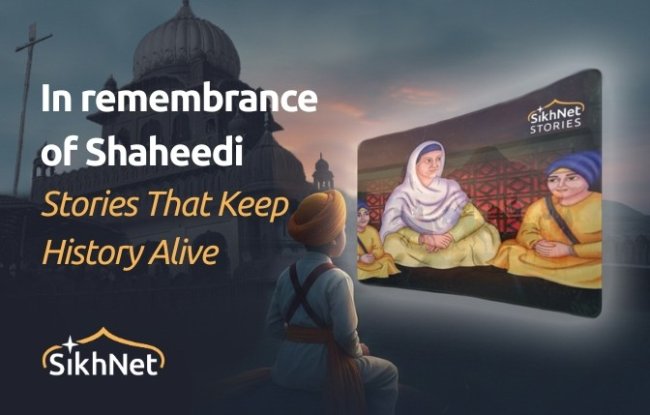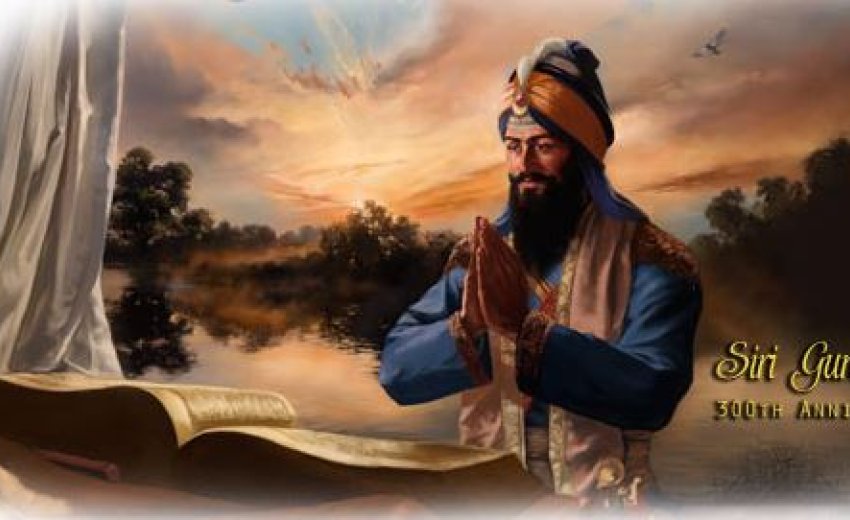A tribute on the tercentenary of Gurta Gaddi)
ਸਭਸਿਖਨ ਕੋ ਹੁਕਮ ਹੈ ਗੁਰੁ ਮਾਨਿਓ ਗ੍ਰੰਥ ।
This is the edict for all the Sikhs; accept the Granth as the Guru ~
(Guru Gobind Singh)
This edict of the tenth Guru makes it easy for the Sikh to answer the question of Sri Guru Granth Sahib being the Guru. For him or her it is the tenth Guru’s edict or Hukam. But there are skeptics.
And there are others who need to be convinced that the scripture can be the Guru. Let us deal with this last aspect first.
 Gurbani speaks strongly against idol worship and other rituals practiced in the Hindu faith. If a Sikh mentions this to a Hindu friend his reply is “you also indulge in idol worship except that a book has replaced the idols”. There is some truth in that because for many of us offering expensive Rumalas, the scripture’s covering, and flowers are considered signs of faith. Some people want the Rumala lifted to have Darshan i.e., a look at the pages of the scripture. That is also considered as faith by them.
Gurbani speaks strongly against idol worship and other rituals practiced in the Hindu faith. If a Sikh mentions this to a Hindu friend his reply is “you also indulge in idol worship except that a book has replaced the idols”. There is some truth in that because for many of us offering expensive Rumalas, the scripture’s covering, and flowers are considered signs of faith. Some people want the Rumala lifted to have Darshan i.e., a look at the pages of the scripture. That is also considered as faith by them.
In short we are ourselves responsible for giving the impression that we worship the Book.
Our learned predecessors, who prepared the Sikh Rehat Maryada, our Code of Conduct,seemed to be aware of this. They laid down that in Ardas (supplication) we should say “Dasaan Paatshaaheean di Jot Sri Guru Granth Sahib ji de Paathdeedar da Dhiaan kar kay bolo Ji Vaheguru”. This indicates that the Sikh cherishes reading and understanding the Word. It is noteworthy that the words are ‘Paath Deedar’ and not ‘Paath Darshan Deedar’ as some of us say. We have to have vision of the Shabad through reading and contemplation and not just by looking at it. They further reinforced this by laying down that when offering Ardas one should face the SGGS if Parkash (opening and installation) has been done otherwise one can face in any direction. Yes we must give full respect to our Guru but please let us not treat it as an idol. The Shabad — the Word — not the volume is the Guru.
Gurbani gives a very interesting analogy to convey how to do Paath. The fifth Gurusays:
ਕੜਛੀਆ ਫਿਰੰਨ੍ਹ੍ਹਿ ਸੁਆਉ ਨ ਜਾਣਨ੍ਹ੍ਹਿ ਸੁਞੀਆ ॥
ਸੇਈ ਮੁਖ ਦਿਸੰਨ੍ਹ੍ਹਿ ਨਾਨਕ ਰਤੇ ਪ੍ਰੇਮ ਰਸਿ ॥੧॥ ੫ ੫੨੧
The spoons keep running through the food but remain deprived of the taste;
those faces glow who enjoy (the Shabad) with love (M: 5, SGGS, p 521).
One should relish doing the Paath.
Let us now come to the subject proper.
Sri Guru Granth Sahib (SGGS) is the only scripture amongst those of all religions that has the status of the Guru. This status was given to the scripture by the tenth Guru Gobind Singh before he shed his mortal frame. It has been stated by some that the tenth Guru bequeathed guru ship to the scripture because all his four sons had been killed. Some say that one goes to a guru to learn and that a guru establishes a personal relationship with the disciple, and ask whether a scripture can do that. Their view is that one needs a physical guru. The purpose of this article is to find answer to these questions.
To start with, let us understand how to recognize a guru. Guru Nanak gives the following two qualities of a true guru:
ਸਤਿਗੁਰੁ ਮਿਲਿਆ ਜਾਣੀਐ ॥ ਜਿਤੁ ਮਿਲਿਐ ਨਾਮੁ ਵਖਾਣੀਐ ॥ ੧ ੭੨
We should know that we have met the true guru if on meeting him we are motivated to remember Naam, the Divine virtues (M: 1, SGGS, p 72).
ਨਾਨਕ ਸਤਿਗੁਰੁ ਐਸਾ ਜਾਣੀਐ ਜੋ ਸਭਸੈ ਲਏ ਮਿਲਾਇ ਜੀਉ ॥੧੦॥ ੧ ੭੨
The true guru is one who brings all the people together (M: 1, SGGS, p 72).
The principal theme running throughout SGGS is of Naam and that itis obtained by the Guru’s grace. Significantly, it starts and ends with this idea. It begins with the Mool Mantar or the Root Mantra which describes Divine virtues and ends with ਗੁਰਪ੍ਰਸਾਦਿ, meaning one can know the Divine Person, God, through the grace of a True Guru.
And the scripture ends thus:
ਤਰਸੁ ਪਇਆ ਮਿਹਰਾਮਤਿ ਹੋਈ ਸਤਿਗੁਰੁ ਸਜਣੁ ਮਿਲਿਆ ॥
ਨਾਨਕ ਨਾਮੁ ਮਿਲੈ ਤਾਂ ਜੀਵਾਂ ਤਨੁਮਨੁ ਥੀਵੈ ਹਰਿਆ ॥੧॥ ੫ ੧੪੨੯
The Lord was kind and I met the true guru;
Naam gives me life and my body and mind blossom (M: 5, SGGS, p 1429).
Guru Arjan says in Sukhmani Sahib:
ਸਤਿ ਪੁਰਖੁ ਜਿਨਿ ਜਾਨਿਆ ਸਤਿਗੁਰੁ ਤਿਸ ਕਾ ਨਾਉ ॥
ਤਿਸ ਕੈ ਸੰਗਿ ਸਿਖੁ ਉਧਰੈ ਨਾਨਕ ਹਰਿ ਗੁਨ ਗਾਉ ॥੧॥ ੫ ੨੮੬
One who has known theCreator is called the true guru;
singing Divine virtues in his company thedisciple is saved (M: 5, SGGS, p 286).
Thus the the guru is one who has known God and in whose company one remembers God. The total scriptureis revealed from the Divine and the gurus say that in so many words. It isrecorded in the Janam Sakhi that whenever Guru Nanak received the Shabad he used to ask his musician companion Mardaana:
ਮਰਦਾਨਿਆ ਰਬਾਬ ਛੇੜ ਬਾਣੀ ਆਈ ਏ।
O Mardaana tune the Rabaab (stringed musical instrument), the word has come from the Divine.
Again he told his disciple Laalo:
ਜੈਸੀ ਮੈ ਆਵੈ ਖਸਮ ਕੀ ਬਾਣੀ ਤੈਸੜਾ ਕਰੀ ਗਿਆਨੁ ਵੇ ਲਾਲੋ ॥ ੧ ੭੨੨-੨੩
I say as the Word comes from the Master (M:1, SGGS, p722-23).
That the gurus had known the Creator is clear. There are other examples recorded about the gurus and saints having experienced the Creator. Bhagats Namdev and Dhanna had their offering of milk consumed; Bhagats Kabir and Namdev were saved from death by Divine presence. Bhagat Ravidas gives evidence at several places of how he converses with God. These have been recorded in their own compositions.
So the entire scripture from the very beginning to the end teaches how to be able to meet the Creator whom they personally experienced.
Let us now study the Divine plan about guru-ship and its implementation. If we delve into Gurbani, which is the name given to the contents of SGGS, and Vaaraan of Bhai Gurdas, some interesting details about the mode of succession of the gurus andtheir pre-ordained number are revealed.
In his conversation with the Sidhas, Guru Nanak said that Shabad, the Divine word is the Guru:
ਸਬਦੁ ਗੁਰੂ ਸੁਰਤਿ ਧੁਨਿ ਚੇਲਾ ॥ ੧ ੯੪੩
The Word is the Guru and consciousness the disciple (M: 1, SGGS, p).
He elaborates on the concept thus:
ਜੇਤਾ ਸਬਦੁ ਸੁਰਤਿ ਧੁਨਿ ਤੇਤੀ ਜੇਤਾ ਰੂਪੁ ਕਾਇਆ ਤੇਰੀ ॥
ਤੂੰ ਆਪੇ ਰਸਨਾ ਆਪੇ ਬਸਨਾ ਅਵਰੁ ਨ ਦੂਜਾ ਕਹਉ ਮਾਈ ॥੧॥ ੧ ੩੫੦
O Lord Your Word is melody for the consciousness of the creation,
whatever we see is the manifestation of Your being;
You enjoy the creation and pervade the universe, there is none but You.
O my mother I cannot say this about any one else (M: 1,SGGS, p 350).
This shows how the guru recognizes the Divine word in his consciousness. The Divine Word is everpresent. The third Guru describes it thus:
ਅਨਹਤ ਬਾਣੀ ਗੁਰ ਸਬਦਿ ਜਾਣੀ ਹਰਿ ਨਾਮੁ ਹਰਿ ਰਸੁ ਭੋਗੋ ॥ 3 921
The Divine word is recognized through the Guru’s Shabad;
and one relishes Naam, or Divine virtues (M: 3, SGGS, p 921).
As may be seen Shabad, the Divine Word is ever present and available to all. One who realizes this is the Guru and through his word the disciple learns. In both cases the word abides inthe consciousness of the receiver. In short the Sikh gets to God through the Guru’s word which is the real guru.
When the disciple rises to the position that he can recognize the Divine word, he becomes fit to be the Guru. This process was used by Guru Nanak to nominate Bhai Lehna as his successor and named him Angad. The Guru transferred his spirit to the disciple, and this is what happened:
ਨਾਨਕਿ ਨਾਮੁ ਨਿਰੰਜਨ ਜਾਨ੍ਯ੍ਯਉ ਕੀਨੀ ਭਗਤਿ ਪ੍ਰੇਮ ਲਿਵ ਲਾਈ ॥
ਤਾ ਤੇ ਅੰਗਦੁ ਅੰਗ ਸੰਗਿ ਭਯੋ ਸਾਇਰੁ ਤਿਨਿ ਸਬਦ ਸੁਰਤਿ ਕੀ ਨੀਵ ਰਖਾਈ ॥ ਕੀਰਤ ੧੪੦੬
Guru Nanak had understood the Naam (virtues) of the impeccable Lord and meditated with devotion.
In his close company Guru Angad became the poet and foundation of the relationship between the Word and consciousness was laid (Keerat, SGGS, p 1406).
This also answers another question as to how all the gurus were able to present all their Baanis (compositions) in verse. There are two reasons. One, the Baani came in that form from the Divine and second the spirit of Guru Nanak made them all celestial poets with the same understanding obviating any contradictions in what they said.
Thus learning from Guru Nanak the second Guru, Angad carried Shabad- imbued consciousness forward, and this continued till the tenth Guru.
This resulted in the same spirit running through all the gurus:
ਜੋਤਿ ਓਹਾ ਜੁਗਤਿ ਸਾਇ ਸਹਿ ਕਾਇਆ ਫੇਰਿ ਪਲਟੀਐ ॥ ਬਲਵੰਡ ੯੬੬
(Guru Angad) had the same light and similar methods, the Master only changed the body (Balwand, SGGS, p 966).
Bhai Gurdas describes the fifth Guru Arjan’s passing of the guru-ship to the sixth Guru, Hargobind similarly:
ਅਰਜਨੁ ਕਾਇਆ ਪਲਟਿ ਕੈ ਮੂਰਤਿ ਹਰਿਗੋਬਿੰਦ ਸਵਾਰੀ ।
ਚਲੀ ਪੀੜੀ ਸੋਢੀਆ ਰੂਪੁ ਦਿਖਾਵਣਿ ਵਾਰੋ ਵਾਰੀ ।
(The spirit of) Guru Arjan changed the body and glorified Hargobind;
thus the lineage of the Sodhis continued and they shall manifest in their turn (Vaar 1, pauri 48).
The Sikhs were anxious to know and asked Guru Hargobind how many more gurus were to come:
ਪੁਛਨਿ ਸਿਖ ਅਰਦਾਸਿ ਕਰਿ ਛਿਅ ਮਹਲਾਂ ਤਕਿ ਦਰਸੁਨਿਹਾਰੀ ।
ਅਗਮ ਅਗੋਚਰ ਸਤਿਗੁਰੂ ਬੋਲੇ ਮੁਖ ਤੇ ਸੁਣਹੁਸੰਸਾਰੀ ।
ਕਲਿਜੁਗੁ ਪੀੜੀ ਸੋਢੀਆਂ ਨਿਹਚਲ ਨੀਂਵ ਉਸਾਰਿਖਲਾਰੀ ।
ਜੁਗਿ ਜੁਗਿ ਸਤਿਗੁਰਿ ਧਰੇ ਅਵਤਾਰੀ ।
The Sikhs asked the Guru “We have seen six Gurus (how many more are to come?") -----
The unfathomable Guru replied “an unshakable foundation for Sodhi Gurus has been laid;
more gurus are to come in their turn and time.” (Vaar 1, Pauri 48).
Dr Jodh Singh of Punjabi University, Patiala has translated “jugi jugi satiguru dharay avataaree” as “Four more Gurus will come to earth (yuga 2, yuga2 i.e. 2+2=4)”.
Bhai Gurdas shows the dialogue continuing in the 49th Pauri where the sixth Guru mentions that according to the Hindu faith Vasudev, Rama and Krishan came in Sat, Treta and Duaapar Yugs (ages) respectively and then says:
ਕਲਿਜੁਗਿ ਨਾਨਕ ਗੁਰ ਗੋਬਿੰਦ ਗਗਾ ਗੋਬਿੰਦ ਨਾਮੁ ਅਲਾਵੈ ।
ਚਾਰੇ ਜਾਗੇ ਚਹੁ ਜੁਗੀ ਪੰਚਾਇਣ ਵਿਚਿ ਜਾਇ ਸਮਾਵੈ ।
In Kalyug it will be from Guru Nanak to Guru Gobind (Singh) reciting the name of the Master.
After these four, the spirit would merge back into the Creator (Vaar 1, Pauri 49).
Bhai Gurdas derives the word Vaheguru also from these four but that is another subject.
So the sixth Guru had told the Sikhs that there were to be ten (6+4) gurus from Guru Nanak to Guru Gobind Singh. This confirms the ordained termination of physical guru-ship after the tenth Guru.
To answer those who advocate continued physical guru-ship, let us consider this. One needs a guru to beguided on the path to salvation. Gurbani says that for this purpose just seeing or meeting the person of the guru would not do. The value of the guru lies in his or her teachings that lead to salvation. The third Guru says:
ਸਤਿਗੁਰ ਨੋ ਸਭੁ ਕੋ ਵੇਖਦਾ ਜੇਤਾਜਗਤੁ ਸੰਸਾਰੁ ॥
ਡਿਠੈਮੁਕਤਿ ਨ ਹੋਵਈ ਜਿਚਰੁ ਸਬਦਿ ਨ ਕਰੇ ਵੀਚਾਰੁ ॥ ੩ ੫੯੪
Every one wants to meet the true guru;
but salvation does not come by seeing,
one must contemplate on the teachings (M: 3, SGGS, p 594).
The fourth Guru says that Baani, the word, is the guru:
ਬਾਣੀ ਗੁਰੂ ਗੁਰੂ ਹੈ ਬਾਣੀ ਵਿਚਿ ਬਾਣੀ ਅੰਮ੍ਰਿਤੁ ਸਾਰੇ ॥
ਗੁਰੁ ਬਾਣੀ ਕਹੈ ਸੇਵਕੁ ਜਨੁ ਮਾਨੈ ਪਰਤਖਿ ਗੁਰੂ ਨਿਸਤਾਰੇ ॥੫॥ ੪ ੯੮੨
Baani is the Guru and Guru the Baani;
Baani is the source of all the nectars for a spiritual life;
when the devotee accepts what the Guru-Baani says;
the Guru manifestly takes the devotee across the world ocean to salvation (M: 4, SGGS, p 982).
Sri Guru Granth Sahib was finalized in two stages. Guru Arjan compiled the first version in 1604 CE and called it Pothi Sahib (revered holy book). Guru Arjan said:
ਪੋਥੀ ਪਰਮੇਸਰ ਕਾ ਥਾਨੁ ॥
ਸਾਧਸੰਗਿਗਾਵਹਿ ਗੁਣ ਗੋਬਿੰਦ ਪੂਰਨ ਬ੍ਰਹਮ ਗਿਆਨੁ ॥੧॥ ਰਹਾਉ ॥ ੫ ੧੨੨੬
Pothi is the place of the Supreme Master;
singing the virtues of the Lord in holy congregation one obtains perfect Divine knowledge (M: 5, SGGS, p 1226).
After writing of Pothi Sahib was completed Baba Budha carried it on his head from Ramsar for installation at the Hari Mandir (now also called Darbar Sahib), Amritsar. Guru Arjan, in order to demonstrate the higher status of the Word over the physical Guru waved the Chaur (Whisk) from behind in reverence. It is also history that after installing Pothi Sahib to its revered position, Guru Arjan started sleeping on the ground.
Thus was laid the foundation for the scripture to be treated as the Guru.
Final shape to Sri Guru Granth Sahib was given by the tenth Guru at Talwandi Sabo in 1708 CE by including the hymns of the Ninth Guru. He was conscious that the completed Granth would be the eternal Guru of the Sikhs. By that time the tenth Guru had considerable compositions of his own but he did not include them in it. The real reason is not for us mortals to fathom but it is easy to see his self-effacement by not including his own Baanis in the scripture, whom he later anointed as the Guru.
The view that the tenth Guru had to anoint the Granth as the Guru because his four sons had been killed assumes that the Guru would have had dynastic interests in mind. We are aware he had personally sent his two elder sons into battle against heavy odds and they sacrificed their lives. History also tells us that when he received the news of the two younger sons being bricked alive he thanked the Almighty for having been able to fulfill his duty. Further, he fought many wars and won, but did not annex even an inch of territory which he would have if he had been guided by self-interest. It is, therefore, hard to believe that he would have nominated any of his sons to succeed him even if they had been alive.
We have already seen that end of physical guru-ship with him was pre-ordained.
Without trying to find any other justification for its guru-ship the scripture’s contents of spiritual teachings justify that status. Guru Nanak said:
ਗੁਰੁ ਸਾਗਰੁ ਰਤਨੀ ਭਰਪੂਰੇ ॥
ਅੰਮ੍ਰਿਤੁ ਸੰਤ ਚੁਗਹਿ ਨਹੀ ਦੂਰੇ ॥
ਹਰਿ ਰਸੁ ਚੋਗ ਚੁਗਹਿ ਪ੍ਰਭ ਭਾਵੈ ॥
ਸਰਵਰ ਮਹਿ ਹੰਸੁ ਪ੍ਰਾਨਪਤਿ ਪਾਵੈ ॥੧॥ ੧ ੬੮੫
The Guru is the ocean full of jewels of spiritual knowledge;
the devotee draws this nectar and does not feel away from the guru;
as s/he relishes the nectar s/he develops love for the Creator;
the devotee thus experiences the Master through the guru (M:1, SGGS, p 685).
The tenth Guru’s edict further said:
ਗੁਰੂ ਗ੍ਰੰਥ ਜੀ ਮਾਨਿਓ ਪ੍ਰਗਟਗੁਰਾ ਕੀ ਦੇਹਿ ।
ਜੋ ਪ੍ਰਭ ਕੋ ਮਿਲਬੋ ਚਹੈ ਖੋਜ ਸਬਦ ਮਹਿ ਲੇਹਿ ।
Accept Guru Granth as the manifest physical Guru;
those who wish to meet God should search the Shabad.
The Sikh gurus walked the earth for a long period of 239 years from the advent of the first Guru in 1469 to the ascension of the tenth in 1708 CE. The scripture also has the compositions of saints and bards of different hues; many of them of earlier periods. The experiences of this protracted period of time enabled almost all the real life situations and questions to be addressed. The scripture contains teachings on spirituality, ethics and social conduct. Being the latest scripture it is relevant for the modern times.
SGGS thus has enshrined in it the wisdom of not just one personality but the combined wisdom of a large number of them with no contradictions. The writings have been preserved and are therefore, authentic. They conform to the principle that while a physical guru dies, the teachings do not; they are eternal if they are preserved in their pristine form as is the case with SGGS:
ਸਤਿਗੁਰੁ ਮੇਰਾ ਸਦਾ ਸਦਾ ਨਾ ਆਵੈ ਨਾ ਜਾਇ ॥
ਓਹੁ ਅਬਿਨਾਸੀ ਪੁਰਖੁ ਹੈ ਸਭ ਮਹਿ ਰਹਿਆ ਸਮਾਇ ॥੧੩॥ ੪ ੭੫੯
My perfect Guru is eternal, not subject to birth and death;
he is the embodiment of the eternal Lord who pervades all (SGGS, p 759).
The scripture is indeed our living eternal Guru.
- By Rawel Singh

